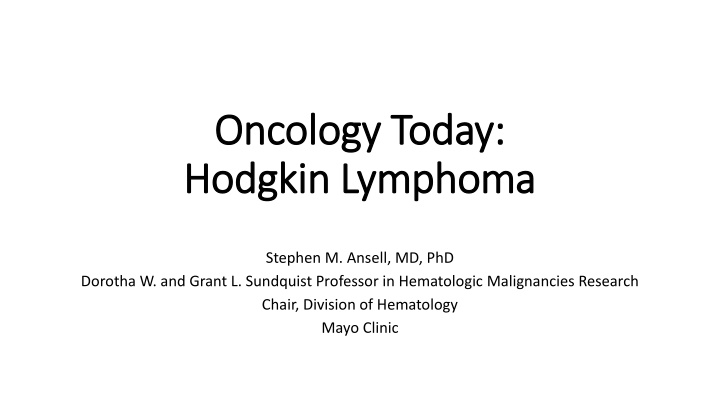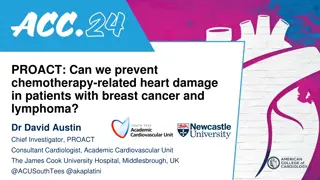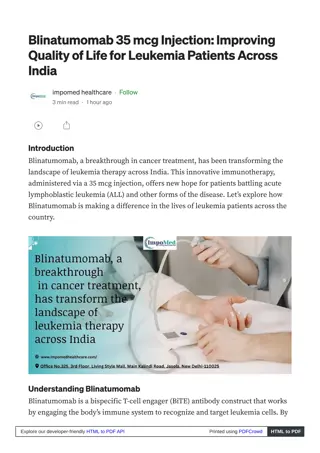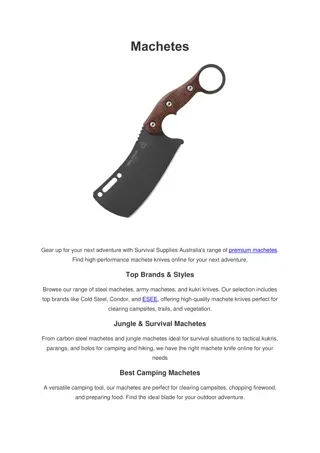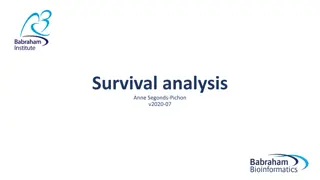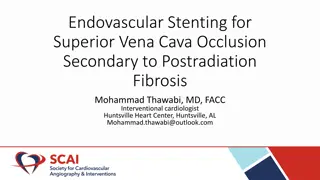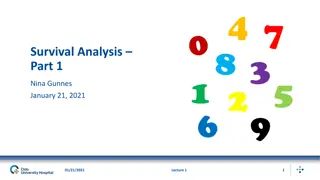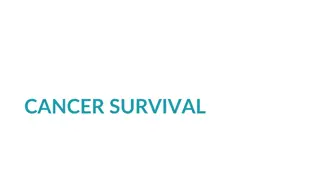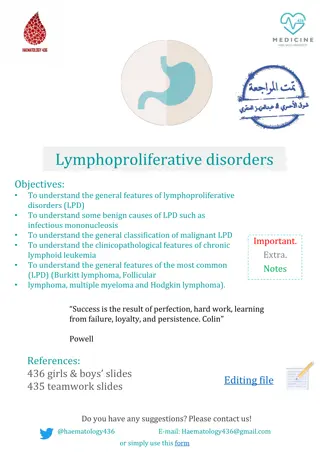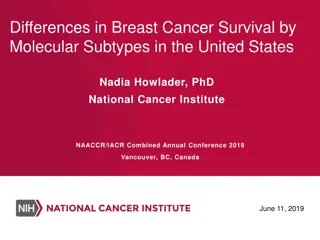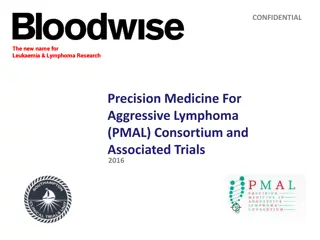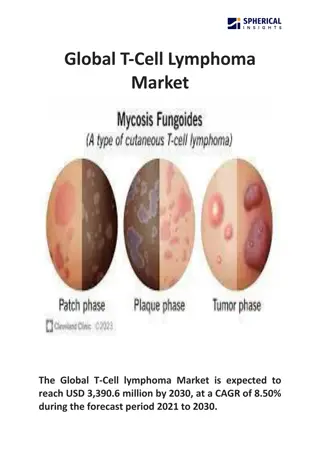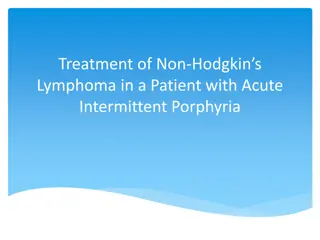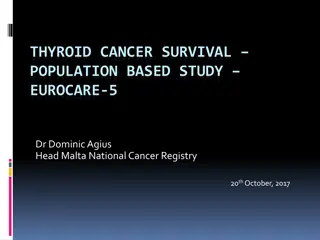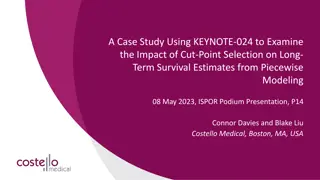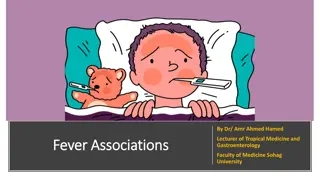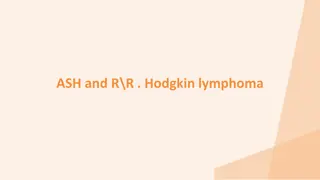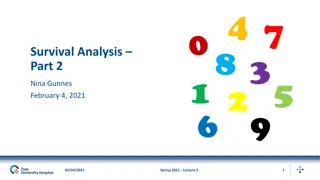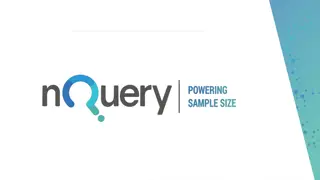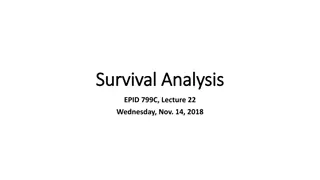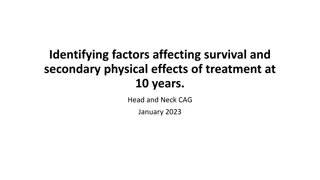A+AVD vs. ABVD in Hodgkin Lymphoma: Improved Overall Survival
Phase 3 study comparing A+AVD and ABVD regimens in Hodgkin Lymphoma showed A+AVD significantly improved overall survival with reduced risk of death. A+AVD had lower incidence of second malignancies compared to ABVD, highlighting its efficacy and safety profile.
Download Presentation

Please find below an Image/Link to download the presentation.
The content on the website is provided AS IS for your information and personal use only. It may not be sold, licensed, or shared on other websites without obtaining consent from the author.If you encounter any issues during the download, it is possible that the publisher has removed the file from their server.
You are allowed to download the files provided on this website for personal or commercial use, subject to the condition that they are used lawfully. All files are the property of their respective owners.
The content on the website is provided AS IS for your information and personal use only. It may not be sold, licensed, or shared on other websites without obtaining consent from the author.
E N D
Presentation Transcript
Oncology Today: Oncology Today: Hodgkin Lymphoma Hodgkin Lymphoma Stephen M. Ansell, MD, PhD Dorotha W. and Grant L. Sundquist Professor in Hematologic Malignancies Research Chair, Division of Hematology Mayo Clinic
Phase 3 ECHELON-1 study design A+AVD x 6 cycles (n=664) Brentuximab vedotin 1.2 mg/kg IV infusion days 1 and 15 Follow-up Every 3 months for 36 months, then every 6 months until study closure EOT CT/PET scan 1:1 randomization (N=1,334) ABVD x 6 cycles (n=670) IV infusion days 1 and 15 Primary endpoint: modified PFS per IRF (previously reported) End-of-cycle-2 PET scan by IRF per Deauville 5-point scale PET : 1 3 PET+: 4 5 Key secondary endpoint: alpha-controlled, event-driven analysis of OS Long-term follow-up assessments: Exploratory analysis of OS among patients who were PET2-positive and PET2-negative PFS per investigator Subsequent treatment use Safety outcomes including: Second malignancies Outcomes of pregnancy among patients and their partners PN resolution and improvement rates Data cut-off for current analysis, June 1, 2021. CT, computerized tomography; EOT, end of treatment; IRF, independent review facility; ITT, intention to treat; IV, intravenous; PET2, PET status at the end of cycle 2. Ansell SM, et al. N Engl J Med. 2022 Jul 28;387(4):310-320.
A+AVD significantly improved OS with a 41% reduction in risk of death compared with ABVD 1.0 0.8 Probability of overall survival Estimated 6-year OS rates: A+AVD: 93.9% (95% CI 91.6 to 95.5) 0.6 ABVD: 89.4% (95% CI 86.6 to 91.7) Number of events: A+AVD: 39; ABVD: 64 0.4 Median OS was not reached Median follow-up 73 months 0.2 A+AVD Log-rank test P-value: 0.009 Hazard ratio, 0.59 (95% CI, 0.40 to 0.88) ABVD Censored 0.0 0 6 12 18 24 30 36 42 48 54 60 66 72 78 84 90 96 102 Number of patients at risk Time (months) from randomization A+AVD 664 638 626 612 598 584 572 557 538 517 494 461 350 209 97 27 4 0 ABVD 670 634 614 604 587 567 545 527 505 479 454 411 308 191 84 11 1 0 Ansell SM, et al. N Engl J Med. 2022 Jul 28;387(4):310-320.
Fewer second malignancies were reported in the A+AVD vs ABVD arm 35 32 30 Number of patients 23 25 17 Hematological malignancies 20 9* 15 Solid tumors 10 14 14 5 0 A+AVD (n=664) ABVD (n=670) *Includes 2 cases of acute myeloid leukemia and 6 cases of B- or T-cell lymphomas; Includes 1 unknown malignancy; Includes 1 case each of acute myeloid leukemia, acute promyelocytic leukemia, and myelodysplastic syndrome, and 13 cases of B- or T-cell lymphomas. Among patients with second malignancies: Two patients on each arm received transplant Three patients on the ABVD arm received prior radiation (none with A+AVD) Ansell SM, et al. N Engl J Med. 2022 Jul 28;387(4):310-320.
Pregnancy and peripheral neuropathy data Pregnancies Peripheral neuropathy Incidence of PN at 2 years of follow-up was greater with A+AVD (67%) vs ABVD (43%) Fertility was not formally assessed A total of 191 pregnancies were reported among patients and their partners (A+AVD: 113; ABVD: 78) Among female patients with A+AVD and ABVD: o Pregnancies: 49 and 28 o Live births*: 56 and 23 Among partners of male patients with A+AVD and ABVD: o Pregnancies: 33 and 33 o Live births*: 40 and 36 No stillbirths were reported in either arm In patients with PN in the A+AVD and ABVD arms, after 6 years follow-up: Treatment-emergent PN either resolved or continued to improve in 86% and 87% Median time to resolution was 16 and 10 weeks A+AVD (n=662) 125 (19) 71 (11) 38 (6) 15 (2) 1 (<1) ABVD (n=659) 59 (9) 39 (6) 16 (2) 4 (<1) 0 Safety population Patients with ongoing PN at last follow-up, n (%) Grade 1 Grade 2 Grade 3 Grade 4 *Some female patients (13 on the A+AVD arm and 3 on the ABVD arm)/partners of male patients (8 on the A+AVD arm and 7 on the ABVD arm) recorded more than one live birth; Resolution was defined as resolved/recovered with or without sequelae or return to baseline or lower severity as of the latest assessment for pre- existing events. Improvement was defined as resolution or a decrease by at least 1 grade from the worst grade with no higher grade thereafter; Patients who were lost to follow-up or died prior to resolution or improvement were not censored (11/16 patients [including the 1 patient with Grade 4 PN] on the A+AVD arm; 4/4 on the ABVD arm). Ansell SM, et al. N Engl J Med. 2022 Jul 28;387(4):310-320.
S1826: A Phase III Randomized Trial of Nivolumab or Brentuximab Vedotin Plus AVD in Patients (Age 12 Years) With Newly Diagnosed Advanced Stage Classical Hodgkin Lymphoma
Pembrolizumab followed by AVD in untreated classical Hodgkin lymphoma Allen PB, et al. Blood. 2021 Mar 11;137(10):1318-1326.
Brentuximab vedotin plus nivolumab as first-line therapy in older patients with Hodgkin lymphoma 46 patients - median age 71.5 years. Median follow-up was 21.2 months, and 35 (76%) of 46 patients completed all 8 cycles of therapy. The first 25 evaluable patients had an ORR of 64%; 52% had a CMR and 12% had a PMR. In all 46 evaluable patients, 22 (48%) patients achieved a CMR and six (13%) achieved a PMR (overall response rate 61%). Cheson BD, et al. Lancet Haematol. 2020 Nov;7(11):e808-e815.
Nivolumab +/- Vinblastine as First-Line Therapy for Elderly, Frail Hodgkin Lymphoma Patients Lazarovici et al. ASH 2021, abstract 232
ABVD followed by BV consolidation in risk-stratified patients with limited-stage Hodgkin lymphoma 41 patients 45% had unfavorable disease After ABVD followed by BV, 37 out of 39 achieved PET-negative status. The 3-year PFS rate was 92%, and the overall survival rate was 97%. All 37 patients who achieved negative PET status after BV consolidation avoided RT and remain in remission with 3-year PFS and OS rates of 100%. Park SI, et al. Blood Adv. 2020 Jun 9;4(11):2548-2555.
Brentuximab vedotin, doxorubicin, vinblastine, and dacarbazine for nonbulky limited-stage classical Hodgkin lymphoma 34 patients Risk was early favorable in 62% and unfavorable in 38%. The best complete response rate was 100%. At a median follow-up of 38 months, the progression-free survival and overall survival were 94% and 97%. Abramson JS, et al. Blood. 2019 Aug 15;134(7):606-613.
BV Combined with Chemotherapy in Patients with Newly Diagnosed Early-Stage, Unfavorable-Risk Hodgkin Lymphoma 117 patients All patients had unfavorable risk disease The best complete response rate was 100%. At a median follow-up of 3.8 years, the progression-free survival and overall survival were 94% and 99%. Kumar A et. al, JCO, 2021; 39:20 (2257-2265)
Nivolumab and AVD in Early-Stage Unfavorable Classic Hodgkin Lymphoma
Nivolumab and AVD in Early-Stage Unfavorable Classic Hodgkin Lymphoma 109 patients - Concomitant (4 cycles of N-AVD) or sequential 4 nivolumab, 2 N-AVD, 2 AVD, followed by 30-Gy ISRT. 46 of 51 (90%) patients receiving concomitant therapy and 47 of 50 (94%) patients receiving sequential therapy achieved CR. 12-month progression-free survival was 100% for patients receiving concomitant treatment and 98% for patients receiving sequential therapy. Br ckelmann PJ, et al. JAMA Oncol. 2020 Jun 1;6(6):872-880.
Early Response to First-Line AntiPD1 Treatment in Hodgkin Lymphoma Voltin CA, et al. Clin Cancer Res. 2021 Jan 15;27(2):402-407.
Brentuximab vedotin plus nivolumab as first salvage in relapsed Hodgkin lymphoma 91 patients received 4 cycles of BV and nivolumab. Patients could proceed to ASCT. ORR was 85%, with 67% achieving a CR. At a median follow-up of 34.3 months, the estimated PFS rate at 3 years was 77% for all patients and 91% for patients undergoing ASCT. Advani RH et al. Blood. 2021 Aug 12;138(6):427-438.
Pembrolizumab Plus GVD As Second-Line Therapy for Relapsed or Refractory cHL 39 patients received pembrolizumab (200 mg IV day 1) and GVD chemotherapy for 2-4 cycles. After response assessment, pts could undergo ASCT. Among 38 evaluable pts, overall and CR rates were 100% and 95%. 36 (95%) patients proceeded to HDT/AHCT All 36 transplanted patients are in remission at a median post-transplant follow-up of 13.5 months (range: 2.66- 27.06 months). Moskowitz et al. J Clin Oncol. 2021 Oct 1;39(28):3109-3117.
Effect of BV Addition to Chemotherapy in Patients with Relapsed/Refractory cHL 718 transplant eligible R/R cHL patients - 391 patients were treated with BV and chemotherapy (BV-cohort), and 327 with chemotherapy alone (Chemo-cohort) followed by ASCT BV to salvage chemotherapy followed by ASCT increases PFS in relapsed, but not in primary refractory cHL patients Driessen et al. ASH 2021, abstract 879
Pembrolizumab Added to ICE Chemotherapy Results in High CMR Rates in R/R cHL 42 patients were enrolled with 37 patients evaluable for the primary endpoint. 16 patients had primary refractory disease. The CMR rate assessed by PET/CT imaging following 2 cycles of PEM-ICE was 86.5% Bryan et al. ASH 2021, abstract 229
Novel Salvage Regimens Lead to Outome in Relapsed Refractory cHL after ASCT 853 patients. 12 institutions BV/Nivo (HR: 0.1 (CI95:0.02-0.4), p<0.01) and CPI (HR: 0.12 (CI95:0.03-0.5), p<0.01) had significantly higher PFS than chemo Desai et al. ASH 2021, abstract 878
Phase III study of pembrolizumab versus brentuximab vedotin in relapsed or refractory classic Hodgkin lymphoma Kuruvilla J, et al. Lancet Oncol. 2021 Apr;22(4):512-524.
CD30 directed CAR T-cells are promising Ramos et al. J Clin Oncol 2020 Nov 10;38(32):3794-3804.
AFM13-complexed CB-Derived NK cells for Refractory/Relapsed CD30+ Hodgkin Lymphoma Infusion of AFM13 CAR-like NK cells CB-derived NK cells GMP lab 3 dose levels 1 x 106/kg 1 x107/kg 1x108/kg Preactivation (IL-12/IL-15/IL-18) Expansion with uAPC K562 feeder cells + IL-2 Precomplexing with AFM13 (100 g/mL) NK NKNK NKNKNK NKNK NKNKNK NK NKNK NK NK NK NKNK NK NK NKNKNK NK NK NK NK NK NK NK NKNK NK NK NK NK D14 AFM13 200 mg IV D7 AFM13 200 mg IV D-15 D-14 D21 AFM13 200 mg IV D28 PET/CT D0 D-5 D-3 D-2 D-4 Fludarabine 30 mg/m2/day Cyclophosphamide 300 mg/m2/day Banked umbilical cord blood Nieto et al. AACR 2022 CT003
AFM-13 Preloaded NK cells - Antitumor Activity % change of index lesion 100 80 Hodgkin Responses were evaluated by PET using Lyric criteria on day 28 of each cycle 17/19 metabolic responses (ORR 89.5%) (10 CR, 7 PR) All 13 patients treated at the RP2D responded (8 CR, 5 PR) 5 CR after C1 8 CR after C2 60 T-NHL 40 20 0 -20 -40 -60 -80 -100 Nieto et al. AACR 2022 CT003
Camidanlumab tesirine (Cami-T) is effective In all 77 patients with classical Hodgkin lymphoma, the overall response was 71%. Hamadani M, et al. Lancet Haematol. 2021 Jun;8(6):e433-e445.
Relapse post transplant Pembrolizumab Plus Vorinostat is effective 30 evaluable pts - ORR 73%, CR rate 33%. Refractory to PD1 (n=18), ORR 56% CR rate 6%. Herrera et al. ASH 2021, abstract 234
Relapse post transplant Ruxolitinib Plus Nivolumab in Relapsed/Refractory cHL 19 patients - all had progressed after CPI Highest ruxolitinib dose 20mg BID (MTD) was reached without DLTs. The combination was well tolerated Best ORR was 75% (12 of 16); Including 3 CRs (19%), 2 PRs (13%), 6 patients had stable disease (SD, 44%) with tumor bulk reduction ranging from 10-45%. Median duration of response was 12.5 months Bachanova et al. ASH 2021, abstract 230
Relapse post transplant Everolimus Plus Itacitinib in Relapsed/Refractory cHL mTOR inhibitor + JAK inhibitor The ORR was 79% (95% CI: 49-95%) with a complete response rate 14% (95% CI: 2-43%). The median progression-free survival was estimated to be 3.8 months (95% CI: 1.8-not reached). Svoboda et al. ASH 2020, abstract 473
Advanced stage Hodgkin Lymphoma 25-year-old male Presents with stage IV disease White blood count 16,000 cells/ l Lymphocyte count 500 cells / l or <8% Albumin 3.8 g/dL Hemoglobin < 10 g/dL Treated with BV+AVD x 6 cycles
Early-Stage Hodgkin lymphoma - Unfavorable 54-year-old male Presents with stage IIA disease Non-bulky mass 4 nodal sites Sedimentation rate 104 Treated with BV+AVD x 4 cycles
Relapsed Hodgkin lymphoma 27-year-old male Presents with stage IIA disease Treated with ABVD x 3 cycles had a CR Now presents with recurrent disease 6 months later Treated with BV+bendamustine x 2 cycles followed by ASCT.
